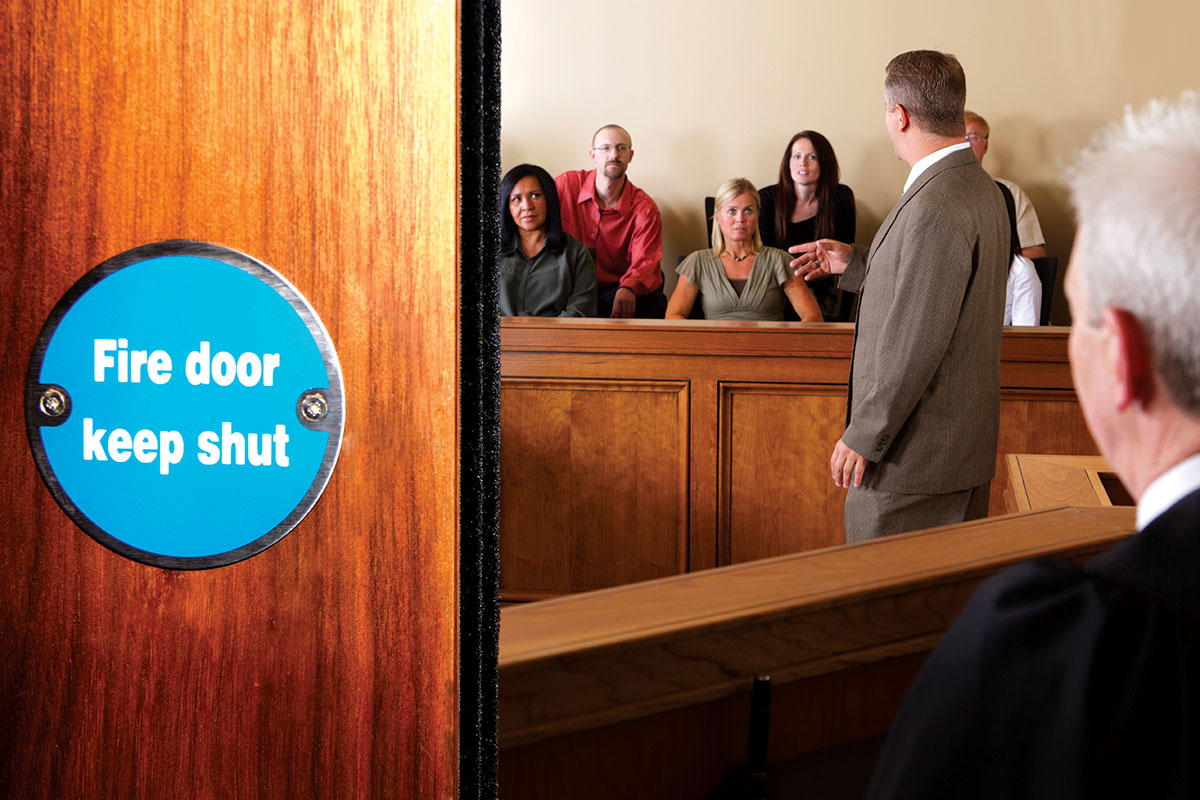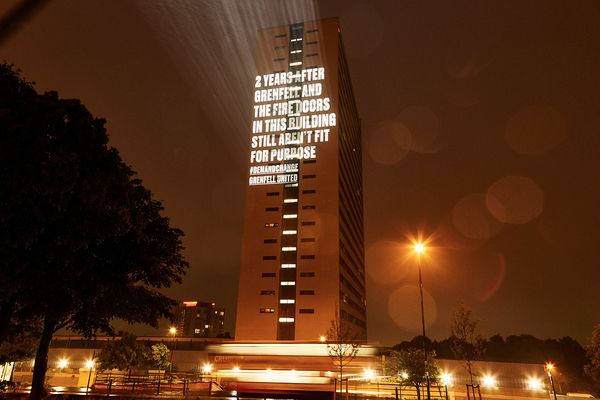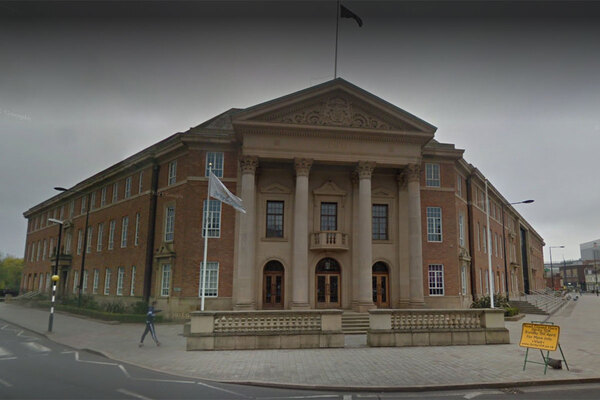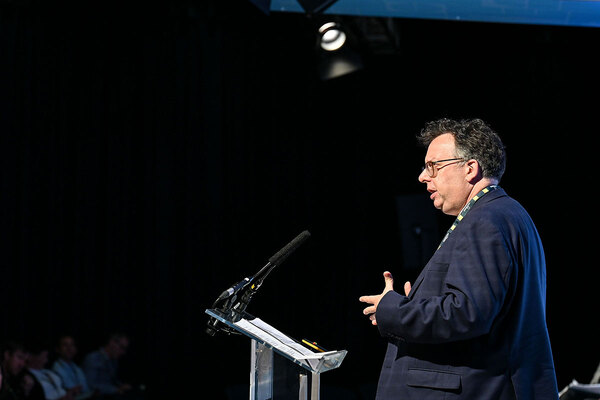You are viewing 1 of your 1 free articles
Mock trial shows seriousness of fire door safety
Installing fire doors improperly has deadly consequences. Gavriel Hollander visits a ‘mock trial’ designed to show how all involved, from manufacturers to installers and beyond, could find themselves liable if things go wrong. Picture by Getty
A fire tears through a city centre hotel in Leeds with more than 600 occupants. Starting in the hotel’s lower ground floor server room, the blaze spread to the ground and first floor, causing the building to be evacuated and at least one guest to suffer smoke inhalation.
Thankfully, the fire at the Sleep Well Hotel is purely fictional. It is the premise for a ‘mock trial’, hosted by the British Woodworking Federation (BWF).
The trial might be staged, but the issue is deadly serious. In the near three years since the Grenfell fire, the issue of fire safety in multi-occupancy buildings has become a matter of national concern. Indeed, last year saw five major residential fires and a number of other serious blazes in hotels – the most recent in December.
In particular, the mock criminal trial focused on fire doors. This again is pertinent. The fire doors at Grenfell failed to meet basic standards in tests after the blaze, triggering scrutiny for the industry which has seen dozens of models of door fail testing (almost all of them composite plastic models).
This is a fully blown crisis for the housing sector, with tens of thousands of non-compliant doors installed around the country.
The organisers of this trial wanted to shine a light on where responsibility can lie when things go wrong, and on how some people in the supply chain might be sleepwalking into disaster.
“What we wanted to do was explore what the liabilities were for our members [typically the manufacturers of timber fire doors] if something goes wrong,” explains Helen Hewitt, chief executive of the BWF. “The trial showed where the liability can be across the entire supply chain.”
Ms Hewitt had a key role on the day, not as herself but playing the part of ‘Helen Crouch’, the technical director of Prime Timber Doors (PTD), the fictional manufacturer of the fire doors used at the hotel where the fire occurred and the defendant in the trial. Ms Crouch was the key witness.
It is highly likely that the door manufacturer would not have been the only company charged, given the circumstances of the ‘fire’, with the main contractor and the hotel owner also potentially liable. But for the purposes of the exercise, we suspended disbelief.
For Ms Hewitt, it was important to show her members – around 60 of whom attended the event – the risks they run if they, or any of their staff or supply chain, cut corners.
“It’s not only the company but the individual person who can be liable,” she tells Inside Housing after the event. “That came out really strongly, and for a number of our members that was an eye opener.”
As for herself, Ms Hewitt got a taste of what it would be like to be in the dock, facing questions over her responsibility for a fire. “If it had been a real court case, I would have been crying,” she admits. “I found the whole process really difficult. It would be a horrible position to put someone in.”
So, what actually happened during the imagined fire and what details did the case hinge on?
The blaze started as an electrical fire on the lower ground floor server room of the hotel – well away from the guestrooms. It spread to the ground and first floor within 30 minutes, despite the presence of a fire door, made by PTD, which was supposed to guarantee the fire be contained in the server room for that 30-minute period.
The door was one of more than 300 installed by Bouch Construction Limited (also fictional) during refurbishment work on the hotel 18 months before the fire.
According to prosecution counsel Jenny Boyden – a real-world senior associate at law firm Russell-Cooke, which arranged the event alongside the BWF – the installation of the doors left “obvious gaps and holes during the refurbishment”, thus allowing the fire to spread more quickly.
While Bouch Construction, as main contractor on the project, would almost certainly have found itself in court alongside PDT in a real-life situation, the prosecution case instead focused on what Ms Boyden described as “three key failures” on the part of the manufacturer.
These were: a failure to ensure doors were designed and constructed in a way that meant they could be installed throughout the hotel; a failure in its duty to ensure tests and examinations were carried out; and a failure to supply the contractor with adequate installation information.
The company was charged under Section 6 of the Health and Safety at Work Act 1974. The issue of testing became the focus for much of the trial. While the prosecution said that the doors and their components should have been accredited by a third party, Ms Crouch argued that the use of a ‘global assessment’ was sufficient. The prosecution told the court that this was because PTD was “averse to spend money on testing”.
Global assessments bring together results from multiple individual tests on fire doors and provide a ‘scope’ based on these tests. It is often recommended that they be used only as part of a third-party certified scheme. In this instance, no third-party testing was carried out and one of the global assessments was found to be out of date.
Kizzy Augustin (centre) as judge, alongside Helen Hewitt (second right) as ‘Helen Crouch’, and Jenny Boyden (far left) as the prosecution counsel
Along with PTD’s failure to give installation instructions to Bouch Construction – even though the contractor did not ask for any – the out-of-date global assessment was a key factor in convincing the majority of the attendees, who acted as a de facto jury, to judge the defendant guilty.
That said, eight people did vote not guilty. Kizzy Augustin, a partner at Russell-Cooke, who played the judge, later tells Inside Housing that the case came down to an understanding of risk, as much as anything else.
“A lot of people came with no expectations but came away understanding how bad it can get if you don’t appreciate risk,” she explains. “[Using] global assessments seems to be a risk. The ‘not guilties’ are seeing it from the technical director’s perspective. They are saying, ‘We know this is what you should do but there are other ways to satisfy your obligation.’ Many clients do not understand the extent of their obligation.”
In other words, there were some BWF members – and potentially some who sit within the supply chain for social landlords – who believed that the defendant had done enough not to be convicted.
Ms Augustin accepts that this could be worrying: “If there was a particular member of staff who was not aware of what happens when things go wrong, I would find that strange. You can get the odd one not familiar with building regulations, but in construction that’s not an excuse.”
Niamh Treacy, commercial and contracts manager at carpentry and joinery firm DPT, was one of those firmly in the ‘guilty’ camp as she watched the proceedings in the ersatz court.
“A global assessment being out of date is pretty black and white,” she says. “The door is not certified. You risk providing something to a project that won’t perform as it should.”
Ms Treacy says that since Grenfell, compliance with building regulations has become more important to her firm than ever. But she explains how this can cause problems with clients.
“For one building, we installed 60-minute smoke doors. The client told us there was a place where the floor level wasn’t right. We said the door would not be a fire door, so we wouldn’t fit it. We face these dilemmas a lot: the client is telling us to do one thing but we are responsible [if things go wrong].”
Because of these dilemmas, Ms Treacy says she would bring “hundreds” of her clients if the event was to be repeated. That is something that Ms Hewitt at the BWF is keen to do.
“We have been asked to run another event that deals with the supply chain,” she says. “A couple of members have approached me already and said they are looking at their internal responsibilities. It’s about people stopping making assumptions and starting to check those assumptions instead.”
As the trial concluded, with the make-believe fire door manufacturer facing a fine of £950,000 and the prospect of making redundancies to pay it, the buzz from attendees was that they would go back to their companies with more understanding of their potential liability.
Many of these companies will have social landlord clients. If a deeper understanding of their responsibility for fire safety is what develops, then hopefully they will help to build safer homes, too.
End Our Cladding Scandal: campaign aims
- Government provides a fund to cover the cost of cladding removal and remedial works on private blocks
- A firm timescale is set out of no more than two years for the work to be carried out
- Residents are reimbursed for the interim fire safety costs incurred, and funding is to be provided for necessary internal fire safety measures identified by a competent fire risk assessor
Sign up for our daily newsletter
Already have an account? Click here to manage your newsletters













